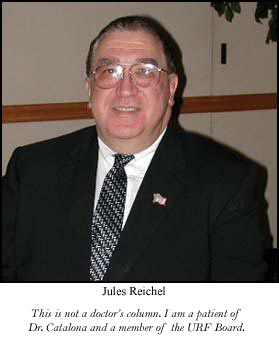One Man To Another: New-Era Of Treatment vs. PSA-Era
This is not a doctors column. I am a patient of Dr. Catalona and a member of the URF Board.

In general, the New Era strategy for prostate cancer is to screen and possibly treat men earlier when the cancer is limited and weak.
The goal is to keep a patients life as it was before the diagnosis and ensuing treatment.
The dramatic reduction in the rates of recurrence from treatment of this extremely dangerous disease, and the avoidance of the great harm to quality of life that previously came with the use of long-term hormonal therapies and experimental drugs, has made the New Era of treatment the most prudent choice for patients.
The emphasis on early diagnosis and treatment in the New Era has also opened up the realistic hope for much simpler treatment of the earliest prostate cancer cells that are called high grade PIN (HGPIN).
While credible doctors have concerns regarding the potential risk of overtreatment caused by earlier diagnosis, that concern should only motivate us to be careful in our medical choices rather than to bypass the new opportunities for best treatment.
A New and Different Strategy
The PSA-Era provided nerve-sparing surgery, and PSA screening (blood test) thresholds set at 4.0ng/ml combined with DRE (Digital Rectal Exam) testing, to detect prostate cancer when it could still be treated with curable intent.
Over the last decade, if there was recurrence after treatment, it was almost universally treated with hormonal therapies.
The New Era of treatment currently provides for:
- Earlier screening beginning at age 40 (or 35 in some cases);
- A PSA screening threshold of 2.5ng/ml with the potential of early biopsy using 12 or more cores;
- Emphasis on improved diagnostic techniques especially including the use of PSA velocity and doubling time to guide the necessity for and the type of treatment;
- Emphasis on viewing surgery and follow-up high dosage radiation therapy (usually IMRT at dosage levels over 70Gy), when required, as a compatible pair of processes rather than only as opposing options;
- Non-invasive treatment of patients with cancer-precursor high grade PIN disease, when appropriate. Many men at age 50 have PIN. The presence of high grade PIN (HGPIN) implies later cancer in almost half of men. (This work is in-progress)
The decline in the death rates in the PSA-Era was NOT good enough
In 2005, 232,090 men will be diagnosed with prostate cancer, 30,350 will die of it, and about 1.6 million men are alive who have had a positive diagnosis.
The total number of men dying each year from prostate cancer has remained about constant over the last decade.
The age-adjusted death rate has been declining at a steady rate of 4% per year since 1994. (Age-adjusted means that 4% more men per year would have died had the treatments not been available.) PSA-Era screening and treatment are given credit for this major achievement.
A death rate decline of 4% per year was too low to persuade all primary care doctors and patients to follow the standard screening guidelines. (CAA Journal for Clinicians 2005)
- About 50% of men with health insurance under 65 years of age were screened last year.
- Above age 65, screening rates were about 60%.
- Lack of health insurance or a fixed provider cause large decreases in screening rates: usually to about 25%.
It has, unfortunately, often become a patient responsibility to ask for screening and for the latest types of medical care. While education about screening is important, the effectiveness of treatment must also be improved.
The Rate of recurrence in the PSA-Era was too high

Recurrence over the 10 years after treatment was much too frequent. On average:
- For Low-risk patients: normally PSA= 10ng/ml or less, and Gleason Score= 6 or less, there was 20% recurrence.
- Medium-risk patients: normally PSA between 10 and 20ng/ml, or Gleason Score = 7, there was 50% recurrence.
- High-risk patients: normally PSA greater than 20ng/ml, or Gleason Score 8-10, there was 66% recurrence.
Overall, the average recurrence rate was about 1/3 of the patients over 10 years, and this statistic is not nearly adequate, especially for a man who typically has a potential 30-year lifespan ahead of him.
Recurrence is feared by all patients
Recurrence is only an arbitrary marker of the rise in PSA after treatment.
The worrisome aspect of recurrence is that it is related to the time until metastasis (spread of the cancer), and metastasis usually implies suffering and death.
Almost all prostate cancer patients have a Gleason Score (level of aggressiveness) between 5 and 10. The Johns Hopkins result, 2003, were that:
For the Gleason Score 5-7 patients, the probability of metastasis varied between 16 and 25% at 7 years; and for the Gleason Score 8-10 patients, the probability of metastasis varied between 43% and 93% at 7 years after recurrence.
For those men who metastasized (usually those with more rapidly rising PSA), the average time to metastasis was about 7.5 years after treatment unless other intervening treatment is successful, and the average time from metastasis to death was 6.5 years. Prostate cancer can greatly shorten life, and recurrence is its marker for trouble.
Hormonal and other drugs for recurrence
The gold standard of care for men with recurrence after surgery or radiation therapy (i.e. men with advanced disease) has been hormonal (or androgen deprivation) therapy (ADT).
The intent is to greatly slow down the growth of cancerous cells by depriving the man of testosterone. Both injection of drugs like Lupron and use of pills such as Casodex become part of a plan for stopping the rise of PSA.
For many men use of ADT is effective. The problems are that ADT has a set of side effects that many men view as unacceptably brutal, and even if they are endured, in time, the cancer is likely to recur without testosterone and the ADT will no longer work.
One alternative has been to use ADT temporarily to drive the PSA level down to undetectable levels and then let the body recover. Some drug is often used to sustain this OFF cycle as long as possible, and ADT is only used again when the PSA rises to some level (PSA=4 is used by Catalona).
This therapy is called intermittent androgen deprivation (IAD).
A new problem for IAD is that the process for picking one or more of the several hundred drugs that are in development or early use that might be suitable for cancer suppression during the OFF cycle, has not been established. Availability of these drugs is also often an issue.
The New-Era offers something better
The lowering of the PSA screening threshold to 2.5 does seem to help.
Dr. Patrick Walsh of Johns Hopkins published his 10-year results in the PSA region 0-4ng/ml:
- Of patients with Gleason Scores of 5-7, recurrence was between only 1 and 18 %. Compare this to 20-50% recurrence for low-to-medium risk patients, above.
- Of patients with Gleason Scores of 8-10, recurrence was only 37%. Compare this to 66% recurrence for high-risk patients, above.
Dr. Catalona described cooperative use of adjuvant and salvage high-dosage radiation therapy in a prior issue of Quest. The recurrent patients usually had about an 80% chance of ending the recurrence with those follow-up treatments.
In the new era using both therapies together:
- Of patients with Gleason scores of 5-7: 96% or better, non-recurrence
- Of patients with Gleason scores of 8-10: 80-93% non-recurrence
These results are with limited or no use of difficult hormonal therapies.
While these results require further validation, at such high levels of outcome success, the best choice for a patient to follow is the New-Era approach for screening and treatment; and its not even a close call.
Feedback
Feedback is encouraged. Contact Dr. Catalona at his Website: www.drcatalona.com or send me an e-mail at jules105@aol.com. To see my prior articles, go to the Website and click on Quest Articles. Then scan down and click below my picture.
Click here to read the next article, The Pathology Point of View (Patient, Know Thy Tumor), in the One Man to Another series from Jules Reichel.











